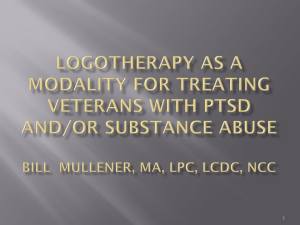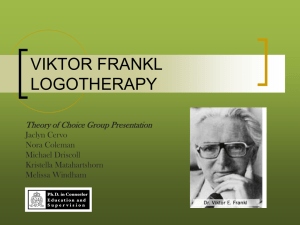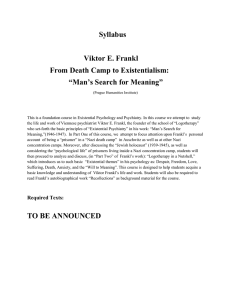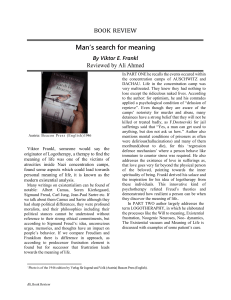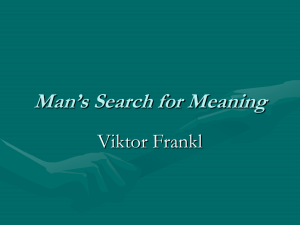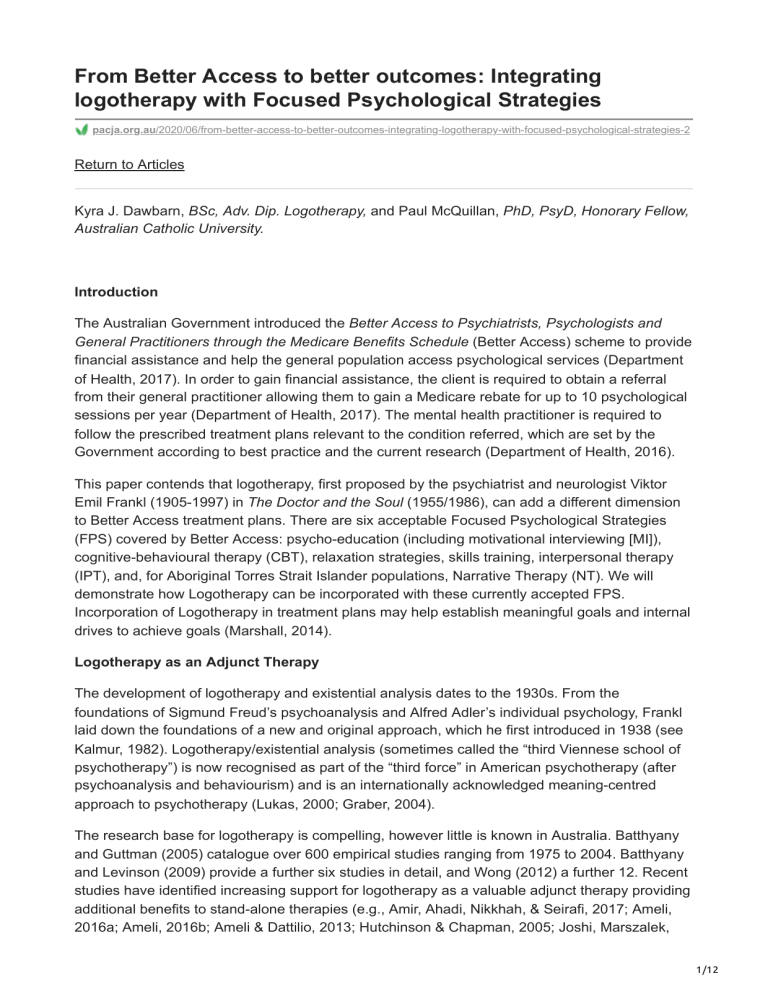
From Better Access to better outcomes: Integrating logotherapy with Focused Psychological Strategies pacja.org.au/2020/06/from-better-access-to-better-outcomes-integrating-logotherapy-with-focused-psychological-strategies-2 Return to Articles Kyra J. Dawbarn, BSc, Adv. Dip. Logotherapy, and Paul McQuillan, PhD, PsyD, Honorary Fellow, Australian Catholic University. Introduction The Australian Government introduced the Better Access to Psychiatrists, Psychologists and General Practitioners through the Medicare Benefits Schedule (Better Access) scheme to provide financial assistance and help the general population access psychological services (Department of Health, 2017). In order to gain financial assistance, the client is required to obtain a referral from their general practitioner allowing them to gain a Medicare rebate for up to 10 psychological sessions per year (Department of Health, 2017). The mental health practitioner is required to follow the prescribed treatment plans relevant to the condition referred, which are set by the Government according to best practice and the current research (Department of Health, 2016). This paper contends that logotherapy, first proposed by the psychiatrist and neurologist Viktor Emil Frankl (1905-1997) in The Doctor and the Soul (1955/1986), can add a different dimension to Better Access treatment plans. There are six acceptable Focused Psychological Strategies (FPS) covered by Better Access: psycho-education (including motivational interviewing [MI]), cognitive-behavioural therapy (CBT), relaxation strategies, skills training, interpersonal therapy (IPT), and, for Aboriginal Torres Strait Islander populations, Narrative Therapy (NT). We will demonstrate how Logotherapy can be incorporated with these currently accepted FPS. Incorporation of Logotherapy in treatment plans may help establish meaningful goals and internal drives to achieve goals (Marshall, 2014). Logotherapy as an Adjunct Therapy The development of logotherapy and existential analysis dates to the 1930s. From the foundations of Sigmund Freud’s psychoanalysis and Alfred Adler’s individual psychology, Frankl laid down the foundations of a new and original approach, which he first introduced in 1938 (see Kalmur, 1982). Logotherapy/existential analysis (sometimes called the “third Viennese school of psychotherapy”) is now recognised as part of the “third force” in American psychotherapy (after psychoanalysis and behaviourism) and is an internationally acknowledged meaning-centred approach to psychotherapy (Lukas, 2000; Graber, 2004). The research base for logotherapy is compelling, however little is known in Australia. Batthyany and Guttman (2005) catalogue over 600 empirical studies ranging from 1975 to 2004. Batthyany and Levinson (2009) provide a further six studies in detail, and Wong (2012) a further 12. Recent studies have identified increasing support for logotherapy as a valuable adjunct therapy providing additional benefits to stand-alone therapies (e.g., Amir, Ahadi, Nikkhah, & Seirafi, 2017; Ameli, 2016a; Ameli, 2016b; Ameli & Dattilio, 2013; Hutchinson & Chapman, 2005; Joshi, Marszalek, 1/12 Berkel & Hinshaw, 2014; Titi, Budi, & Novy Helena, 2018; Vos, Craig, & Cooper, 2014). Effectiveness studies for logotherapy have also indicated a reduction in symptoms and an improvement in self-efficacy and goal setting (e.g., Engel & Yusuf, 2013; Faramarzi & Bavali, 2017; Hajiazizi, Bahmani, Mahdi & Tavakoli, 2017; Hamidi, Manshee, & Fard, 2013; Joshi, Marszalek, Berkel, & Hinshaw, 2014; Montrell, 2020; Robatmili, et al., 2015; Thompson, 2016; Vos, Craig & Cooper, 2014). Research is also providing validation for the logotherapeutic model (Joshi et al., 2014) and the potential practical application of logotherapy into the health profession (Mortell, 2020). In logotherapy, the search for a meaning in life is identified as the primary motivational force in human beings. Frankl (1959/1987) outlined his own experiences of the concentration camps, seeing them as positive proof of both this quest for meaning and what he termed “the defiant power of the human spirit” (p. x). Frankl (1955/1986) saw the human being as three-dimensional; “the somatic (soma), the mental (psyche), and the spiritual (nóós)” (p. xvi). This third dimension (the noetic) is not “spirit” in a religious sense, but rather the ultimate essence of the human, the capacity to take a decision despite circumstance. It is this third dimension that can be neglected in diagnoses of somatic or psychological issues. Logotherapy aims to add to existing treatments by actualising the human spirit—that uniquely human capacity to take a stand, to take a decision, even in the most difficult of circumstances. Frankl (2004) suggested an alternative classification system that includes the noetic dimension of the human being. He developed a dual axis concept that allows symptoms that may seem to present as either psychological or physical problems to be classified in a way that includes the noetic dimension (Frankl, 2004). His classification system focuses on the origins of mental health concerns, postulating that how the symptoms manifest does not necessarily define their etiology. Logotherapy allows for a deeper understanding of the origins of mental health concerns and can provide the mental health worker with a more focused plan that does not simply address the symptoms but aims to resolve their underlying cause. For example, Frankl speculates that medical conditions (such as liver disease) can result not only in physical symptoms presenting in the somatic dimension (such as pain and jaundice), but also as psychological symptoms which have their ultimate source in the noetic dimension (Frankl, 2004). Noetic concerns may be due to what Frankl terms reactive neuroses (such as anticipatory anxiety due to a physical symptom) or iatrogenic neuroses (reaction to medical intervention when the patient’s symptoms are not validated, or are prematurely diagnosed, or the patient is not helped to objectify their symptoms). In essence, Frankl suggests that mental health concerns, although manifesting in the psychological or physical dimensions, may have their origin, at least in part, in the noetic. Psycho-Education Psycho-education allows health professionals to provide information and prevalence rates to clients relevant to their diagnosis (Lukens & McFarlane, 2004). This allows the client and their support networks to better understand their diagnosis and feel comforted they are not alone; it may normalise their mental health condition, or alert them to potential warning signs of relapse (Lukens & McFarlane, 2004). Awareness and education of common responses may highlight patterns of behaviour the client may wish to alter, and may provide them with strategies on how to alter these behaviours (Lukens & McFarlane, 2004). Recognition of behavioural patterns may allow the client to implement these strategies earlier in the therapy to effectively achieve desired behaviour more quickly (Australian Institute of Professional Counsellors, 2014). 2/12 Logotherapy recognises the client is more than their diagnosis (Frankl, 1969; 2004). A logotherapist would be sure to allow the client to see themselves as more than prevalence rates and diagnostic guidelines. Conversations focusing on psycho-education would also address concerns of stigma and what the client’s perceptions and implications of the diagnosis are, whilst attempting to address these concerns (Frankl, 2004). A logotherapist would deliver psychoeducation in a way that involved: inviting the client to express aspects of themselves outside these classifications, emphasising that prevalence rates and potential side effects of mental health issues are not guaranteed, and preventing the client from feeling like a victim of their diagnosis (Frankl, 1969; 2004). A logotherapist would also offer psycho-education about the noetic dimension and its potential impacts: how to accept the reality of the situation and ways to progress towards meaning (Frankl, 2004). A fundamental difference between psycho-education and logotherapy is that the former can be delivered by the mental health practitioner as an expert opinion rather than generated from client-led discussions. A logotherapist, on the contrary, encourages the clients’ interactions and reactions to expert opinions, realising they do not fully define the person. A logotherapist helps to guide the client to explore aspects of their life and gain insight. While offering psycho-education, the mental health practitioner invites the client to discuss information provided and provide their opinion (Frankl, 1969). Concepts achieved through self-exploration and insight are often more meaningful to clients, have a longer lasting and greater effect, and are more relevant to clients and their situation (Frankl, 1969; 2004). Logotherapy, when used in conjunction with psycho-education, can allow the client to be more than their diagnosis, encourage client involvement, allow for acceptance of reality, and facilitate self-realisations, thus creating a longer-lasting and more profound effect (Frankl, 1969; 2004). Motivational Interviewing MI is a specific form of psycho-education. Based on positive psychology, MI focuses on constructive behavioural change (Jones, Latchford, & Tober, 2015; Miller & Moyers, 2017). Similar to Logotherapy, MI uses a collaborative relationship, allows the client to feel heard, minimises confrontation, and enhances autonomy in a non-judgmental environment (Csillik, 2015; Jones et al., 2015). MI aims to enhance discrepancies between the client’s values and their current behaviours and resolve ambivalence, thus strengthening the client’s motivation to change (Jones et al. 2015; Miller & Moyers, 2017). During this process of highlighting discrepancies, clients may become aware of a lack of meaning in their life and gain meaning by reconciling these discrepancies (Frankl, 2004). According to Frankl, the belief in meaning and the journey to discovering ultimate meaning are the main drives of human existence (Frankl, 2004). Like logotherapy, MI also believes that enhancing intrinsic motivation by using core values, rather than externally enforced behaviour changes, often results in a more permanent and sustainable change (Csillik, 2015; Jones et al., 2015). MI has a less formal structure than other therapies and allows clients to recognise triggers and reinforcers for comorbid conditions. It explores the combined role each condition plays in the maintenance of symptoms (Josephson, Carlbring, Forsberg, & Rosendahl, 2016). Like MI, logotherapy is more a communication style than a set of techniques. Logotherapy also embraces several aspects of MI (e.g., establishing rapport, setting agenda, assessing readiness to change, sharpening the focus, and identifying ambivalence), allowing for easy integration of the two approaches (Bundy, 2004; Jones et al. 2015; Miller & Moyers, 2017). Logotherapy may allow the client to gain a greater perspective, not only assisting motivation for a single issue, but also providing life motivation applicable to multiple individual challenges. Using a combination of MI 3/12 and logotherapy may allow the client to see benefits they were not previously aware of, by viewing things from different perspectives and identifying meanings that may in turn change current behaviour. According to Frankl (2004), many psychological issues have their origins in the noetic dimension and MI arguably focuses on the noetic dimension, allowing the client to focus on external forces rather than internal concerns that may result in mental health concerns such as depression. When used in conjunction with MI, logotherapy can highlight lack of meaning identified by discrepancies in the client’s narrative. Logotherapy utilises the client’s core values and internal desires to change and to live meaningfully. It can also teach skills applicable to other areas in which life lacks meaning, identifying potential meanings that may change current behaviour (Frankl, 2004). Cognitive-Behavioural Therapy CBT is one of the most commonly-used and heavily-researched therapies today. CBT believes our thoughts, rather than external forces, cause our feelings and behaviours (National Association of Cognitive-Behavioural Therapists [NACBT], 2018). It is a collaborative therapy where the mental health practitioner actively seeks to understand the client and their goals (NACBT, 2018). Therapy consists of empathetic listening, encouragement, and psycho-education and aims to teach clients how to behave in order to achieve their goals (NACBT, 2018). CBT challenges “irrational” belief systems by comparing thought processes to facts and examining their validity (NACBT, 2018). CBT aims to offer an inspiration to change “maladaptive” or “illogical” thoughts, whilst logotherapy offers a holistic approach and inspiration to live, mobilising clients’ strengths and encouraging them to embrace every aspect of life (Ameli, 2016; Ameli, 2016b; Benware, 2003; Frankl, 1969). A combination of these two approaches encourages clients to understand their world, modify their behaviour, and find meaning and purpose in their lives. One of the main techniques of CBT is Socratic dialogue (NACBT, 2018). Originally, Socratic dialogue referred to the discussion of moral and philosophical problems (Farlex, 2018). Logotherapy uses Socratic dialogue to contemplate the meaning of life itself (Frankl, 1969). In CBT, Socratic dialogue refers to the use of deliberately posed questions designed to allow the client to critically examine their ideas, acknowledge contradictions, and determine their validity (NACBT, 2018). Logotherapy also uses deliberate questions, however it goes beyond validity of ideas and allows the client to examine the philosophy of life itself. Both CBT and logotherapy explore current and previous attempts to combat issues of concern to the client, and determine the possibility of successful therapeutic outcomes. However, logotherapy adds to the intrinsic value of the dialogue by exploring client’s systems of meaning (Benware, 2003; NACBT, 2018). CBT helps alter the conditioning process applied to the psyche, whilst logotherapy looks outwards and provides meaning, leading to long-term changes. CBT gradually implements strategies, as a result of Socratic dialogue, aiming at altering thought patterns and allowing the client to control their emotions when confronted with inevitable undesirable situations (NACBT, 2018). Logotherapy accepts that there is unavoidable suffering, however, it is the meaning derived from this suffering that is important (Frankl, 1969). CBT focuses on the emotional consequences of undesirable situations, whereas logotherapy provides meaning to assist clients to cope with what might be unavoidable emotional distress. 4/12 Logotherapy aims to view all clients neutrally, and attempts to minimise the importance of diagnosis, allowing the client to be seen as more than a label or list of symptoms (Benware, 2003). This is particularly important for effective therapy, as the mental health practitioner’s views of the client can affect their diagnosis, treatment, and case formulation (Benware, 2003). Free will is a premise of both CBT and logotherapy, where the client is able to make decisions instead of being a victim of their environment (Benware, 2003). Traditionally CBT only formally acknowledges two dimensions to the human psyche, the cognitive and emotional dimensions. However, CBT has begun to accept the spiritual dimension of the person (Benware, 2003). A limitation of the CBT model is explanation of complex human emotions (e.g., compassion and altruism) arising purely from higher order thinking, however, incorporation of logotherapy and the noetic allows for a more in-depth analysis of core beliefs and associated thinking. Overall, logotherapy can assist CBT in the following ways: increase the value identified in the client’s previous attempts and successes, add an additional dimension to Socratic dialogue, provide a sense of meaning for undesirable situations, and help explain limitations to the CBT model (Benware, 2003; Frankl, 2004). Relaxation Therapy Relaxation therapy teaches clients techniques to aid relaxation and concentrate on pleasant situations in order to alleviate undesirable symptoms such as pain or anxiety (Vickers & Zollman, 1999). Relaxation therapy aims to alert the client to moments of stress in their daily life and implement strategies to combat that tension (Vickers & Zollman, 1999). Relaxation techniques allow the client to become more aware of their environment, but not be too involved in thinking about it, which is similar to the logotherapy technique of self-distancing (Vickers & Zollman, 1999), the initial step in a logotherapy encounter (Lukas, 1979; 2000). Self-distancing aims to separate the person from their experiences, minimise their emotional attachment, and gain a different perspective (Frankl, 2004; Vickers & Zollman, 1999). Unfortunately, clients often integrate their psychological diagnosis into their identities (Graber, 1993). However, gaining distance may provide beneficial strategies, highlight freedom (i.e., the way someone choses to respond to adversity), and help create an identity without incorporating the stigma associated with a mental health condition (Graber, 1993). Once successful distancing has been achieved, logotherapy can be used to engage with meaning (Graber, 1993). It is worth noting, however, that logotherapy is only applicable to mild to moderate psychological problems, including anxiety and depression. Logotherapy can be incorporated, for more serious diagnoses, after other treatment methods have already provided some relief to the client. Overall, incorporation of relaxation strategies and logotherapy can enhance self-distancing from mental health concerns, limit the clients association of the mental health condition with their identity, highlight potential areas of freedom, and help clients engage with meaning (Frankl, 2004; Graber, 1993; Vickers & Zollman, 1999). Skills Training Another acceptable FPS is skills training, which is used by a wide range of mental health professionals and can be used for anger management, management of stress levels, relaxation, increasing assertiveness, emotional regulation, and enhancing problem solving, social, communication and parenting skills (Australian Association of Social Workers, 2018; Linehan, 2014). Skills training from a sports psychology perspective also includes imaginary skills and goal setting (Birrer & Morgan, 2009). Imaginary skills can be enhanced through logotherapy by 5/12 allowing the client to remember and describe moments of meaning in their past and imagine scenarios which may provide them with meaning in the future. Once a potential meaning is identified, the logotherapist works with the client to define their goals and help develop strategies to actualise them. Logotherapy also addresses potential barriers to meaning (including poor communication skills, anger or stress management, and problem solving skills) by developing specific strategies in collaboration with the client (Frankl, 1969). Logotherapy complements skills training by highlighting and exploring previous systems of meaning, proposing future meanings, and addressing potential barriers to meaning (Frankl, 1969). Interpersonal Therapy IPT is a brief attachment-focused therapy where the client’s interpersonal relationships are explored. IPT proposes there is an inverse relationship between the client’s life events and relationships, and their moods (Robertson, Rushton, & Wurm, 2008). IPT aims to improve the client’s expectations and quality of interpersonal relationships, allowing them to deal with current interpersonal distress (Robertson et al., 2008). Frankl believed that a main source of discovering meaning is achieved by uplifting experiences, the most powerful of which is love and human connection (Frankl, 1969). Therefore, one of the main sources of meaning can be achieved improving and maintaining healthy interpersonal relationships. Similar to Frankl’s theory of inescapable realities of life (mainly death and suffering), IPT recognises that we will all experience grief and loss as part of the human condition (Frankl, 1969; Robertson et al., 2008). IPT also states that some transitional periods (such as loss of health) may contain both positive and negative elements (Robertson et al., 2008). Logotherapy allows a client to rise above negative situations and find meaning in suffering (Frankl, 1969). Exploring the positive aspects of a challenging situation can improve both physical and emotional health (Pattakos, 2007). By exploring the meaning of loss of health, for example, the client may highlight positives of their condition (such as positive social networks, inner strengths, or providing inspiration to others). IPT practices both directive and non-directive exploration, clarification, communication analysis, role-play, and problem solving (Robertson et al., 2008). Similarly to logotherapy, if a person is not able to find meaning or interpersonal satisfaction in their life, then change is required, and this is often achieved by focusing on others rather than internal meaning (Robertson et al., 2008). Although logotherapy does not prescribe developing new attachments when faced with grief, a client may indirectly develop new attachments and interpersonal connections through the pursuit of meaningful activities (Frankl, 1969). Another important concept of logotherapy is self-transcendence, which occurs when you reach beyond yourself, serve a higher purpose, and embrace your suffering to benefit others (Frankl, 1969). Self-transcendence allows the client to see prospects and directions for their life and its values. Interpersonal skills are essential to achieve this. The ability to recognise others’ needs and communicate to them their ability to help, allows an individual to facilitate self-transcendence. Allowing the client to strengthen their interpersonal relationships may open pathways for selftranscendence previously not available, or provide meaning to the client through establishing new interpersonal relationships (Frankl, 1969). Logotherapy explores communication barriers and problem-solving issues, as long as they are of significance to the client. However, it also places great importance on the roles a person plays. IPT discusses the importance of roles and role transitions and defines old and new roles in a 6/12 balanced and realistic way to make them more acceptable to the client (Robertson et al., 2008). IPT examines the skills required and the attitudes towards roles necessary to help overcome perceived challenges (Robertson et al., 2008). These attitudes are also discussed in logotherapy, allowing the client to embrace the importance of their role and their uniqueness in their ability to fulfill it (Frankl, 1969). This uniqueness allows the client to gain meaning from fulfilling their role (Frankl, 1969). Logotherapy can enhance IPT by allowing the client to rise above negative situations and find meaning in their suffering, highlighting the positives in negative experiences, emphasising the importance of change, embracing the importance of the client’s role and their uniqueness to fulfil it, and facilitating self-transcendence (Frankl, 1969; Robertson et al., 2008). Narrative Therapy NT holds that a person is a collection of stories, with significant stories shaping their identity (Jensen, 2011, White & Epston, 1990). NT aims to identify the client’s values and abilities, while recognising their previous success in actualising their values (Jensen, 2011). Highlighting the positives in the client’s stories allows them to gain self-esteem and identify with a more positive image of their achievements (Jensen, 2011). This is important to allow the client to recognise their past achievements (and identify areas that provide them meaning in their life) and build confidence to implement changes to pursue future meanings (Jensen, 2011). Community membership allows a person to develop traditions and a sense of contribution, similar to the logotherapy’s concept of self-transcendence (Hazell, 2018). In addition to listening to the client’s stories, the mental health practitioner should listen to the meaning and values hidden behind their words to help establish meaningful goals and identify the clients’ values (Jensen, 2011). However, logotherapy cautions against a purely inward focus, believing it may lead to noetic problems (e.g., a crisis of conscience, feelings of emptiness, or loss of meaning). Therefore, incorporating logotherapy to extend the person beyond their own story may allow the client to gain more meaning and satisfaction from their life (Frankl, 1969; Frankl, 2004). NT sees an individual as multi-tiered, with multiple possibilities waiting to be discovered (Jensen, 2011). Like logotherapy, NT views clients as separate from their problems, allowing the client to gain some distance (Jensen, 2011). The holistic approach, incorporating the spiritual aspect of the person, is becoming more prominent in both the medical and psychological fields (Hazell, 2018). Social and emotional wellbeing have recently gained much attention within psychological and educational circles, with particular attention given to developing healthy foundations for children (Hazell, 2018). Although they do not specifically mention the existence of the nóós or spiritual dimension of a person (as in logotherapy), they acknowledge the importance of the spiritual aspect of a person (Hazell, 2018). Logotherapy can further supplement NT by preventing an inward focus, increasing client’s satisfaction and meaning, and highlighting a sense of contribution via self-transcendence (Frankl, 1969; 2004; Jensen, 2011). Conclusion This paper has outlined how logotherapy can be an effective adjunct therapy to all the acceptable FPS in Australia, benefitting clients in a multitude of ways. Frankl’s classification system provides a different approach to viewing mental health by determining if the root cause of a problem is in the noetic dimension and providing a broader focus for therapy. Logotherapy is already an 7/12 established therapy accepted by the Government in Austria (European Association for Psychotherapy, 2020b), the original home of much of modern psychology. It is also an approach approved by the European Association for Psychotherapy (European Association for Psychotherapy, 2020a). It is also taught at university level in Moscow and South Africa, as well as by the Viktor Frankl Institute Vienna, which has chapters based around the globe. Logotherapy currently embraces many of the aspects of the acceptable FPS discussed in this paper and could add additional benefits to the client. The incorporation of the spiritual aspect of a person may be particularly beneficial to clients with cultural beliefs that focus on spiritual aspects, and or collectivist cultures (such as Aboriginal and Torres Strait Islanders), however further evidence-based trials may be required to confirm this. The introduction of logotherapy to existing psychological assessment and treatment processes in Australia may determine the effectiveness of logotherapy as an adjunct therapy within an Australian context. These effectiveness studies and future evidence-based trials, as are beginning to happen in other jurisdictions (see De Angelis, 2018), may provide support allowing logotherapy’s incorporation as an approved psychological strategy under the Better Access scheme. This could help ensure that Better Access leads to better outcomes for clients, because, as Hill (2018) observes, “almost every problem that’s brought into therapy is implicitly about the meaning of life”. References Ameli, M. (2016a). Reason, meaning, and resilience in the treatment of depression: Logotherapy as a bridge between cognitive-behaviour therapy and positive psychology. In P. Russo-Netzer., S. E. Schulenberg, & A. Batthyany (Eds.), Clinical perspectives on meaning: Positive and existential psychotherapy (pp. 223-244) (, Cham, Switzerland: Springer International. https://doi.org/10.1007/978-3-319-41397-6_11 Ameli, M. (2016b). Integrating logotherapy with cognitive behavior therapy: A worthy challenge. In A. Batthyany (Ed.), Logotherapy and existential analysis (pp. 197-217). Cham, Switzerland: Springer International. Ameli, M., & Dattilio, F. M. (2013). Enhancing cognitive behavior therapy with logotherapy: Techniques for clinical practice. Psychotherapy, 50(3), 387. https://doi.org/10.1037/a0033394 American Psychiatric Association. (2013). Diagnostic and statistical manual of mental disorders (5th ed.). Washington, DC: Author. https://doi.org/10.1176/appi.books.9780890425596 Amir, F., Ahadi, H., Nikkhah, K., & Seirafi, M. (2017). The effectiveness of acceptance and commitment group therapy and group logotherapy in reducing perceived stress among MS patients. Caspian Journal of Neurological Sciences, 3(4), 175-184. https://doi.org/10.29252/nirp.cjns.3.11.175 Australian Association of Social Workers (2018). CPD requirements for AMHSWs. Retrieved from: http://www.aasw.asn.au/practitioenr-Resources/cpd-requirements-for-amhsw Australian Institute of Professional Counsellors. (2014). Psychoeducation: Definition, goals and methods. Retrieved from: http://www.aipc.net.au/articles/psychoeducation-definition-goals-andmethods 8/12 Batthyany, A., & Guttmann, D. (2005). Empirical research on logotherapy and meaning-oriented psychotherapy: An annotated bibliography. Phoenix, AZ: Zeig, Tucker & Theisen Inc. Batthyany, A., & Levinson, J. (Eds.) (2009). Existential psychotherapy of meaning: Handbook of logotherapy and existential analysis. Phoenix, AZ: Zeig, Tucker & Theisen Inc. Benware, J. M. (2003). On the compatibility of cognitive therapy and logotherapy. The International Forum for Logotherapy, 26, 49-57. Birrer. D., & Morgan. G. (2009). Psychological skills training as a way to enhance an athlete’s performance in high-intensity sports. Scandinavian Journal of Medicine & Science in Sports, 20(2), 78-87. https://doi.org/10.1111/j.1600-0838.2010.01188.x Bundy, C. (2004). Changing behaviour: Using motivational interviewing techniques. Journal of the Royal Society of Medicine, 97(44), 43-47. Csillik, A. (2015). Positive motivational interviewing: Activating clients’ strengths and intrinsic motivation to change. Journal of Contemporary Psychotherapy, 45, 119–128. https://doi.org/10.1007/s10879-014-9288-6 De Angelis, T. (2018) In search of meaning. Monitor on Psychology, 49(9), 38. Retrieved from: https://www.apa.org/monitor/2018/10/cover-search-meaning Department of Health (2016). Fact sheet: Focussed Psychological Strategies continuing professional development. Retrieved from: https://www.health.gov.au/internet/main/publishing.nsf/Content/mental-ba-focus Department of Health (2017). Better access to mental health care: Fact sheet for patients. Retrieved from: https://www1.health.gov.au/internet/main/publishing.nsf/Content/betteraccess_factsheet_for_patients Engel, J. D., & Yusuf, S. (2013). The effectiveness of the logotherapy counseling model development to improve low self-esteem of women victims of trafficking. International Journal of Education, 7(1), 27-42. European Association for Psychotherapy. (2020a). Approaches. Retrieved from: https://www.europsyche.org/approaches/ European Association for Psychotherapy. (2020b). Austria. Retrieved from: https://www.europsyche.org/situation-of-psychotherapy-in-various-countries/austria/ Farlex (2018). The free dictionary. Retrieved from: https://www.thefreedictionary.com/socratic+debate Frankl, V. (1955/1986). The doctor and the soul (3rd ed.). New York: Random House. Frankl, V. (1959/1987). Man’s search for meaning: an introduction to logotherapy. London: Hodder and Stoughton. Frankl, V. E. (1969). The will to meaning: Foundations and applications of Logotherapy. New York: Penguin Group. 9/12 Frankl, V. (2004). On the theory and therapy of mental disorders (Tr. James Du Bois). New York: Brunner-Routledge. Graber, A. V. (1993). The Logoanchor Technique. The International Forum for Logotherapy, 2, 26-30. Graber, A. V. (2004). Viktor Frankl’s Logotherapy: Method of choice in ecumenical pastoral psychology. Lima, OH: Wyndham Hall Press. Hajiazizi, A. H., Bahmani, B., Mahdi, N., & Tavakoli, V. M. (2017). Effectiveness of group logotherapy on death anxiety and life expectancy of the elderly living in boarding houses in Kerman. Salmand: Iranian Journal of Ageing, 12(2), 220-231. https://doi.org/10.21859/sija1202220 Hamidi, E., Manshee, G. R., & Fard, F. D. (2013). The Impact of Logotherapy on Marital Satisfaction. Procedia – Social and Behavioral Sciences, 84, 1815-1819. https://doi.org/10.1016/j.sbspro.2013.07.040 Hazel, G. (2018). Finding a place for resilience in teacher preparation. In M. Wosnitza, F. Peixoto, S. Beltman, & C. F. Mansfield (Eds.), Resilience in education: concepts, contexts and connections (1 ed., pp. 221-235). Switerland: Springer. https://doi.org/10.1007/978-3-319-766904_13 Hill, C. E. (2018). Meaning in life: A therapist’s guide. Washington, DC: American Psychological Association. https://doi.org/10.1037/0000083-000 Hutchinson, G. T., & Chapman, B. P. (2005). Logotherapy-enhanced REBT: An integration of discovery and reason. Journal of Contemporary Psychotherapy, 35(2), 145-155. https://doi.org/10.1007/s10879-005-2696-x Jensen, P., E, B. (2011). Why should psychiatrists learn about narrative therapy? Australian and New Zealand Journal of Psychiatry, 45, 709-711. https://doi.org/10.3109/00048674.2011.589370 Jones, S, A., Latchford, G., & Tober, G. (2015). Client experiences of motivational interviewing: An interpersonal process recall study. The British Psychological Society, 89, 97–114. https://doi.org/10.1111/papt.12061 Josephson, H., Carlbring, P., Forsberg, L., & Rosendahl, L. (2016), People with gambling disorder and risky alcohol habits benefit more from motivational interviewing than from cognitive behavioral group therapy. Journal of Life and Environmental Sciences, 4(1899), 1-14. https://doi.org/10.7717/peerj.1899 Joshi, C., Marszalek, J. M., Berkel, L. A., & Hinshaw, A.B. (2014). An empirical investigation of Viktor Frankl’s logotherapeutic model. Journal of Humanistic Psychology, 54(2), 227-253. https://doi.org/10.1177/0022167813504036 Kalmur, S. (1982). A brief history of Logotherapy. (pp. xv-xxiv) In Analecta Frankliana: The Proceeding of the First World Congress of Logotherapy: 1980. Berkeley, CA: Institute of Logotherapy Press. Linehan, M. M. (2014). DBT Skills Training Manual. New York: Guilford Publications. 10/12 Lukas, E. (1979) The four steps of Logotherapy in J. Fabry, R. Bulka, & W. Sahakian (Eds.), Logotherapy in action (pp. 95-106). New York: Jason Aronsen. Lukas, E. (2000) Logotherapy textbook: Meaning-centred psychotherapy consistent with the principles outlined by Viktor E. Frankl, MD. (Trans. Theodor Brugger) Toronto, Canada: Liberty Press. Lukens, E. P., & McFarlane, W. R. (2004). Psychoeducation as evidence-based practice: Considerations for practice, research, and policy. Brief Treatment and Crisis Intervention, 4(3), 205-225. https://doi.org/10.1093/brief-treatment/mhh019 Marshall, E. (2014). Freedom of will and personality: A logotherapeutic approach to the diagnosis and treatment of personality disorders. The International Forum for Logotherapy, 37, 71-75. Miller, W. R., & Moyers, T. B. (2017). Motivational interviewing and the clinical science of Carl Rogers. Journal of Consulting and Clinical Psychology, 85(8), 757–766. https://doi.org/10.1037/ccp0000179 Mortell, S. (2020). Logotherapy to mitigate the harmful psychological effects of current events: A Tool for nurses. Journal of Psychosocial Nursing and Mental Health Services, 58(4), 38-42. https://doi.org/10.3928/02793695-20200127-01 National Association of Cognitive-Behavioural Therapists (2018). What is Cognitive-Behavioral Therapy (CBT)? Retrieved from: https://www.nacbt.org/whatiscbt-htm/ Pattakos, A. (2007). Prisoners of our thoughts: Viktor Frankl’s principles for discovering meaning in life and work. Williston, VT: Berrett-Koehler Publishers Robatmili, S., Sohrabi, F., Shahrak, M. A., Talepasand, S., Nokani, M., & Hasani, M. (2015). The effect of group logotherapy on meaning in life and depression levels of Iranian students. International Journal for the Advancement of Counseling, 37(1), 54-62. https://doi.org/10.1007/s10447-014-9225-0 Robertson, M., Rushton, P., & Wurm, C. (2008). Interpersonal Psychology: An overview. Psychotherapy in Australia, 14(3), 46-54. Thompson, G. R. (2016). Meaning Therapy for Addictions: A Case Study. Journal of Humanistic Psychology. 56(5), 457–482. https://doi.org/10.1177/0022167815585913 Titi, S. S., Budi, A. K, & Novy Helena, C. D. (2018). Effect of logo-therapy, acceptance, commitment therapy, family psychoeducation on self-stigma, and depression on housewives living with HIV/AIDS. Enfermeria Clinica, 28, 98-101. https://doi.org/10.1016/S11308621(18)30046-9 Vickers, A., & Zollman, C. (1999). ABC of complementary medicine: Hypnosis and relation therapies. British Medical Journal, 319, 1346-1349. https://doi.org/10.1136/bmj.319.7221.1346 Vos, J., Craig, M., & Cooper, M. (2014). Existential therapies: A meta-analysis of their effects on psychological outcomes. Journal of Consulting and Clinical Psychology, 83(1), 115–128. https://doi.org/10.1037/a0037167 11/12 White, M., & Epston, D. (1990). Narrative means to therapeutic ends. New York: W. W. Norton. Wong, T. P. P. (2012). The human quest for meaning: Theories, research, and applications. New York: Taylor & Francis Group. Return to Articles 12/12



